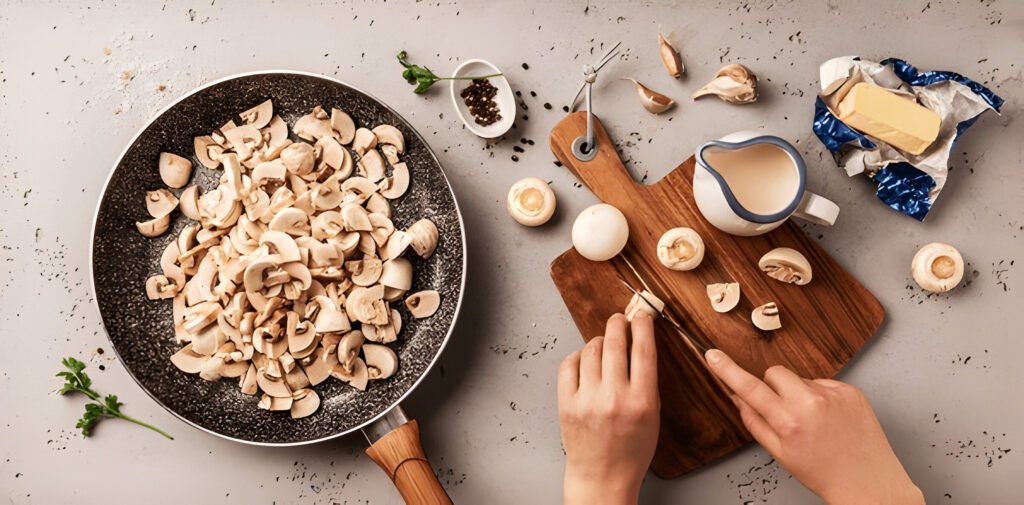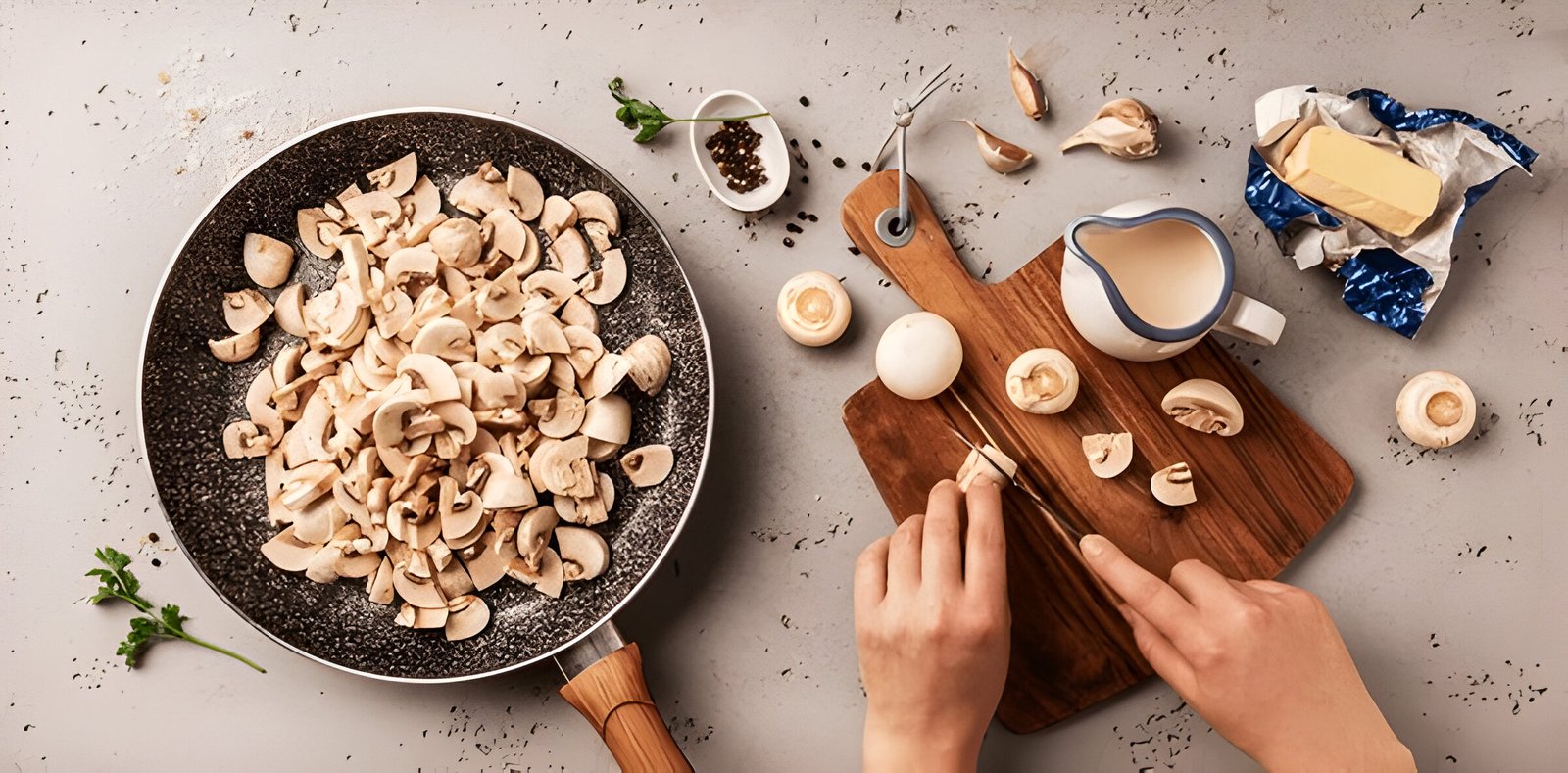Image Credit: Shutterstock

Mushrooms are a delightful addition to many dishes, but knowing how to tell if mushrooms are bad is crucial for both safety and flavor. These fungi can spoil quickly, potentially causing unpleasant tastes or even health issues if consumed past their prime. Understanding the signs of mushroom spoilage ensures that only fresh, high-quality mushrooms make it to your plate.
This guide will explore the key indicators of mushroom freshness and deterioration. Readers will learn to identify fresh mushrooms, recognize common signs of spoilage like brown spots or a fishy smell, and understand proper storage techniques. The article will also cover when to discard mushrooms and provide expert tips to help consumers make informed decisions about their mushroom purchases and usage.
Identifying Fresh Mushrooms
Appearance of Fresh Mushrooms
Fresh mushrooms have distinct visual characteristics that indicate their quality. The cap size and condition are crucial factors to consider. Ideal mushrooms have large caps with minimal stems, and their caps should be whole and intact without any discoloration or dry, shriveled patches. The color of fresh mushrooms is typically uniform, with no dark spots or blemishes.
When examining mushrooms, one should pay attention to their surface texture. Fresh specimens have a smooth, even surface without cracks or pits. Some varieties may have a slight sheen, but they should never appear slimy or excessively moist. The cap’s shape can vary depending on the mushroom type, ranging from convex to conical or even depressed.
Texture and Firmness
The texture of fresh mushrooms is a key indicator of their quality. When touched, they should feel springy and light, never spongy or mushy. Fresh mushrooms have a firm texture that bounces back when gently pressed. They should be faintly damp to the touch but not wet or slimy.
Firmness is another crucial aspect of fresh mushrooms. They should maintain their shape and not collapse easily when handled. The stem should be sturdy and not bend or break with slight pressure. If the mushroom feels soft or gives way easily, it may be past its prime.
To ensure freshness, consumers should also consider the mushroom’s aroma. Fresh specimens have an intensely sweet and earthy smell. Any sour or fishy odors are clear signs of spoilage and should be avoided. By carefully examining these aspects, one can confidently select fresh, high-quality mushrooms for culinary use.
Common Signs of Mushroom Spoilage
Visual Indicators
Mushrooms that are starting to spoil often exhibit noticeable changes in appearance. Fresh mushrooms should have a consistent color, but as they deteriorate, they may develop dark spots, bruises, or an overall dull appearance. If mushrooms have begun growing fuzzy mold or their color has noticeably changed, they should be discarded. Sliminess is another clear visual indicator of spoilage. When mushrooms appear wet or have a shiny, slippery surface, it’s a sign that they’re no longer fresh and have begun to decompose.
Odor Changes
The smell of mushrooms can be a reliable indicator of their freshness. Most fresh mushrooms have a mild, earthy aroma that’s barely noticeable. However, as they spoil, mushrooms can develop strong, unpleasant odors. If a mushroom emits a sour, fishy, or generally foul smell, it’s a clear sign that it has gone bad. Some spoiled mushrooms may have aromas reminiscent of rotten cabbage or dirty diapers. It’s important to note that while some mushroom species naturally have distinct aromas, any strong, off-putting smell is usually a sign of spoilage.
Texture Alterations
The texture of mushrooms changes significantly as they spoil. Fresh mushrooms should feel firm and dry to the touch. As they deteriorate, mushrooms often become soft, mushy, or shriveled. If a mushroom feels sticky or slimy when touched, it’s no longer suitable for consumption. Similarly, if mushrooms are drying out or appear downright shriveled, they’re past their prime. These texture changes indicate that the mushrooms have begun to break down and are no longer safe to eat.
How to Properly Store Mushrooms
Ideal Storage Conditions
Proper storage is crucial to maintain the freshness and quality of mushrooms. They should be kept in a cool, well-ventilated environment to prevent spoilage. The ideal temperature for storing mushrooms is below 70°F (21°C). It’s important to note that freezing is not recommended, as it can form ice crystals that damage the mushrooms’ integrity.
Moisture is the enemy of mushrooms, so it’s essential to store them in a dry environment. Using desiccants like silica gel packs can help absorb any residual moisture within the storage container. Regular inspection of stored mushrooms is necessary to check for signs of mold or degradation.
Packaging Options
The right packaging can significantly extend the shelf life of mushrooms. An airtight container, such as a glass jar or a vacuum-sealed plastic bag, is ideal for preventing moisture from entering and causing deterioration. For those who prefer eco-friendly options, brown paper bags with or without paper towels have proven effective in prolonging mushroom freshness.
When selecting packaging, consider the type of mushroom. Different varieties have specific requirements:
- Button mushrooms: Store in breathable packaging to prevent moisture buildup.
- Portobello mushrooms: Use larger containers to accommodate their size.
- Shiitake mushrooms: Store in paper bags to maintain their texture.
- Exotic varieties: Use specialized packaging to protect delicate structures.
For optimal results, clean and sort mushrooms before packaging. Remove any dirt, debris, or damaged parts. This preparation step is critical to ensure the longevity and quality of the mushrooms. By following these storage guidelines, consumers can enjoy fresh mushrooms for up to two weeks, reducing food waste and maximizing their culinary potential.
When to Discard Mushrooms
Safety Considerations
Knowing when to discard mushrooms is crucial for maintaining food safety in the kitchen. Consumers should be vigilant about checking the freshness and expiration date of mushrooms before use. Several visual cues indicate that mushrooms are no longer suitable for consumption:
- Sliminess: When mushrooms develop a slimy texture, it’s a clear sign they’ve been stored too long and should be discarded.
- Wrinkles: While slight drying is acceptable, mushrooms with noticeable wrinkles are past their prime and should not be consumed.
- Dark spots: The presence of dark spots suggests the mushrooms are beginning to spoil.
- Color changes: If mushrooms appear darker than usual or have an overall dull appearance, they’re likely going bad.
- Fuzzy mold: Any visible mold growth is a definite indicator that the mushrooms should be thrown away.
Additionally, a foul or “off” smell is a strong indicator that mushrooms have spoiled and should be discarded immediately. Fresh mushrooms typically have a mild, earthy aroma, so any unpleasant odor is cause for concern.
Health Risks of Consuming Bad Mushrooms
Eating spoiled mushrooms can lead to serious health issues. Consuming mushrooms that have gone bad may result in food poisoning symptoms, including:
- Nausea
- Vomiting
- Diarrhea
- Abdominal pain
In more severe cases, consuming spoiled mushrooms can cause liver damage. It’s important to note that while some mushroom varieties, like inky caps, can cause adverse reactions when consumed with alcohol, most health risks associated with mushrooms stem from eating those that have spoiled.
To ensure safety, it’s best to discard any mushrooms that show signs of spoilage or are past their prime. When in doubt, it’s always safer to throw them out rather than risk potential illness.
Conclusion
Understanding how to identify and store mushrooms properly has a significant impact on both culinary enjoyment and food safety. By paying attention to visual cues, texture, and aroma, consumers can easily distinguish fresh mushrooms from spoiled ones. This knowledge empowers individuals to make informed decisions about their mushroom purchases and usage, ultimately enhancing their cooking experiences.
Proper storage techniques and timely disposal of spoiled mushrooms are crucial to prevent health risks. By following the guidelines outlined in this article, readers can extend the shelf life of their mushrooms and reduce food waste. Remember, when in doubt about a mushroom’s freshness, it’s always better to err on the side of caution and discard it. This approach ensures that only the best quality mushrooms make their way into your dishes, guaranteeing both safety and flavor.
FAQs
Q: How can you determine if mushrooms are still good to eat?
A: To assess whether mushrooms have gone bad, check for these signs: sliminess or stickiness, wrinkles or shriveling, dark spots, a darker color than usual, a soft and spongy texture, a strong odor, or any signs of mold.
Q: What are the indicators of spoiled mushrooms?
A: Spoiled mushrooms often exhibit bruises or dark spots, have a slimy and wet texture, and may appear slightly darker in color than fresh ones. Typically, fresh mushrooms should have dry surfaces and look plump.
Q: How can you tell if the environment for mushroom cultivation is compromised?
A: If you notice a strong, unpleasant odor coming from the containers or growing medium, see mushrooms that are misshapen or stunted, or spot molds like white or blue-green growths, the mushroom culture may be compromised.
Q: What are the signs that cremini mushrooms have spoiled?
A: Cremini mushrooms are likely bad if they exhibit sliminess, wrinkles, dark spots, or an overall darker color. If they have been stored for more than two weeks, they probably have gone bad. A foul smell is another indicator of spoilage.




